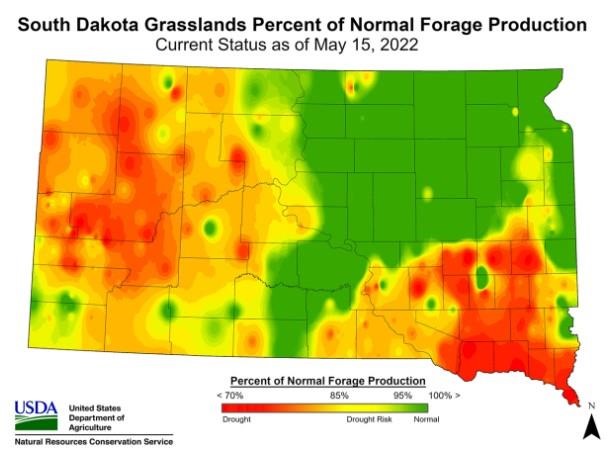By Heather Gessner
With drought conditions continuing across the state, livestock producers will be making hard decisions on livestock inventory numbers as pasture and feed availability become an even more significant factor.
The May 23, 2022, Crop Progress report lists that 45 percent of South Dakota pastures are rated as Poor or Very Poor. This number is similar to a year ago, when 43 percent of the grazing acres were in these categories. However, different this year is the 11% degradation of acres listed in the Excellent and Good categories. Twenty-five percent of pasture acres were listed in the Excellent and Good categories in 2021, compared to 15 percent in 2022.

Figure 1. South Dakota Grasslands Percent of Normal Forage Production, May 15, 2022.
The progress ratings coincide with the May 15, 2022, Natural Resources Conservation Service (NRCS) Percent of Normal Forage Production map (Figure 1). The May map indicates that approximately 60 percent of the state’s pastureland is yielding 70 to 80 percent of normal.
These two resources indicate that summer grazing and the hay crop will be lower than usual this summer.
Lower summer forage production will cause many producers to look toward alternative feed options this summer and later into fall and winter. An extenuating circumstance many will also face is a reduced amount of feed as carryover.
The May 2022 hay stocks were 1,090,000 tons compared to 2,200,000 tons in 2021 and 2,350,000 tons in 2020. This multi-year stock reduction is worrisome, as producers have limited feed available to keep livestock off pastures at the start of the grazing season, which further reduces hay stocks on hand.
Reduced production and decreasing stocks will lead to herd inventory reductions over the summer. These factors will also increase the price of hay and other forages harvested throughout 2022. As a result, farmers and ranchers must keep their drought management triggers in mind this summer. Following a systematic action plan for herd reduction based on forage production will allow producers to feed the remaining animals correctly.
Source : sdstate.edu